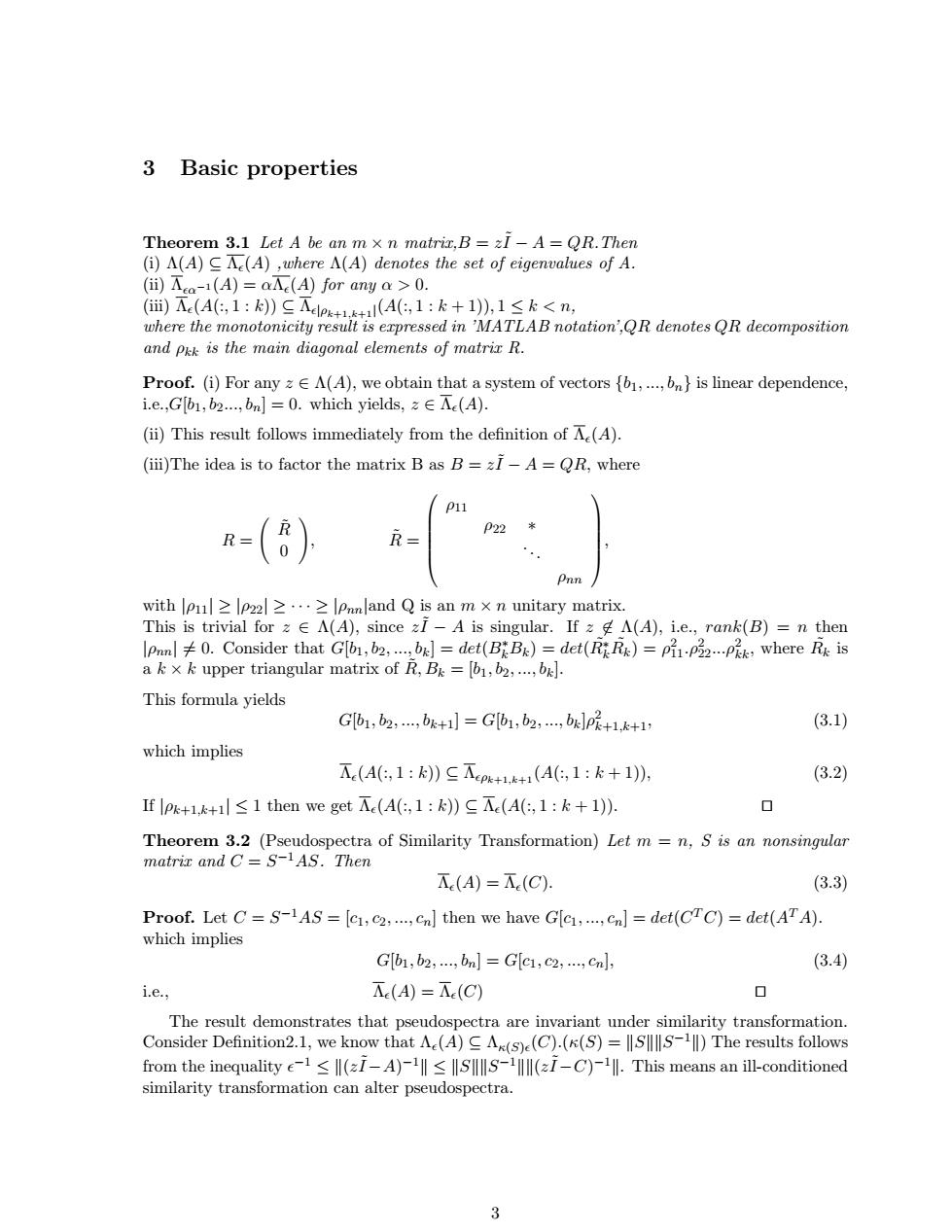正在加载图片...

3 Basic properties Theorem 3.1 Let A be an m x n matrix,B =zI-A=QR.Then (i)A(A)CA(A),where A(A)denotes the set of eigenvalues of A. (ii)Nea-1(A)=aAc(A)for any a>0. ()e(A6,1:)Cps++a(A(,1:k十1),1≤k<n, where the monotonicity result is expressed in 'MATLAB notation,QR denotes QR decomposition and pkk is the main diagonal elements of matrir R. Proof.(i)For any 2A(A),we obtain that a system of vectors {b1,..,bn}is linear dependence, i.e.,G61,62...,on]=0.which yields,z Ae(A). (ii)This result follows immediately from the definition of A(A). (iii)The idea is to factor the matrix B as B=2-A=QR,where p11 p22 0 with P1≥lp22l≥·≥IPan land Q is an m×n unitary matrix. This is trivial for 2 A(A),since 2I-A is singular.If A(A),i.e.,rank(B)=n then Ipnn0.Consider that Go,b2,..]=det(BB)=det(RiR)=pi.p22...k:where Rk is a k x k upper triangular matrix of R,B=[61,b2,...,bk]. This formula yields Gb1,b2,,bk+1]=G[b1,b2,…,b]p2+1k+1, (3.1) which implies 不c(A,1:)Cep+1k+1(A(,1:k+1), (3.2) If +1 then we get A(A(:,1:K))CAc(A(:,1:k+1)). ▣ Theorem 3.2 (Pseudospectra of Similarity Transformation)Let m n,S is an nonsingular matrix and C=S-1AS.Then 工(A)=(C) (3.3) Proof.Let C=S-1AS=[c1,c2,..,cn]then we have G[c1,...cn.]=det(CTC)=det(ATA). which implies G[b1;b2;...;bn]=G[c1,c2,....cn], (3.4) i.e., A(A)=A.(C) ◇ The result demonstrates that pseudospectra are invariant under similarity transformation. Consider Definition2.1,we know that A(A)CA(5)(C).((S)=S)The results follows from the inequality e1<(-A)<S]S-(I-C)-.This means an ill-conditioned similarity transformation can alter pseudospectra. 33 Basic properties Theorem 3.1 Let A be an m × n matrix,B = z ˜I − A = QR.Then (i) Λ(A) ⊆ Λ²(A) ,where Λ(A) denotes the set of eigenvalues of A. (ii) Λ²α−1 (A) = αΛ²(A) for any α > 0. (iii) Λ²(A(:, 1 : k)) ⊆ Λ²|ρk+1,k+1| (A(:, 1 : k + 1)), 1 ≤ k < n, where the monotonicity result is expressed in ’MATLAB notation’,QR denotes QR decomposition and ρkk is the main diagonal elements of matrix R. Proof. (i) For any z ∈ Λ(A), we obtain that a system of vectors {b1, ..., bn} is linear dependence, i.e.,G[b1, b2..., bn] = 0. which yields, z ∈ Λ²(A). (ii) This result follows immediately from the definition of Λ²(A). (iii)The idea is to factor the matrix B as B = z ˜I − A = QR, where R = Ã R˜ 0 ! , R˜ = ρ11 ρ22 ∗ . . . ρnn , with |ρ11| ≥ |ρ22| ≥ · · · ≥ |ρnn|and Q is an m × n unitary matrix. This is trivial for z ∈ Λ(A), since z ˜I − A is singular. If z 6∈ Λ(A), i.e., rank(B) = n then |ρnn| 6= 0. Consider that G[b1, b2, ..., bk] = det(B∗ kBk) = det(R˜∗ kR˜ k) = ρ 2 11.ρ2 22...ρ2 kk, where R˜ k is a k × k upper triangular matrix of R, B ˜ k = [b1, b2, ..., bk]. This formula yields G[b1, b2, ..., bk+1] = G[b1, b2, ..., bk]ρ 2 k+1,k+1, (3.1) which implies Λ²(A(:, 1 : k)) ⊆ Λ²ρk+1,k+1 (A(:, 1 : k + 1)), (3.2) If |ρk+1,k+1| ≤ 1 then we get Λ²(A(:, 1 : k)) ⊆ Λ²(A(:, 1 : k + 1)). ut Theorem 3.2 (Pseudospectra of Similarity Transformation) Let m = n, S is an nonsingular matrix and C = S −1AS. Then Λ²(A) = Λ²(C). (3.3) Proof. Let C = S −1AS = [c1, c2, ..., cn] then we have G[c1, ..., cn] = det(C T C) = det(AT A). which implies G[b1, b2, ..., bn] = G[c1, c2, ..., cn], (3.4) i.e., Λ²(A) = Λ²(C) ut The result demonstrates that pseudospectra are invariant under similarity transformation. Consider Definition2.1, we know that Λ²(A) ⊆ Λκ(S)² (C).(κ(S) = kSkkS −1k) The results follows from the inequality ² −1 ≤ k(z ˜I −A) −1k ≤ kSkkS −1kk(z ˜I −C) −1k. This means an ill-conditioned similarity transformation can alter pseudospectra. 3